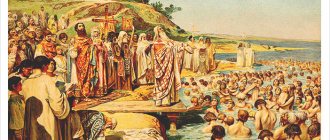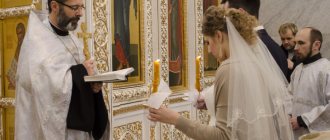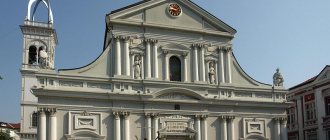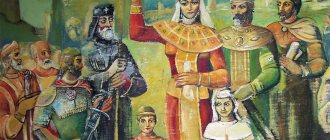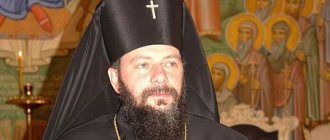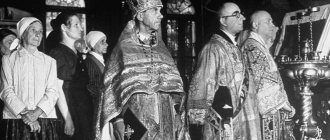Georgia was one of the first in the world to adopt Christianity as a state religion, along with Armenia. Therefore, the religious culture in the country is very developed. Most parents raise their children by instilling in them faith in Jesus Christ and the saints.
Georgians treat icons with respect. Both a simple peasant and a rich businessman have a “red corner” in their house, where there is always an icon of the Georgian Mother of God. Among the Orthodox population, the archangels Gabriel and Michael, St. Nicholas of Myra, St. Barbara, St. George the Victorious and others are revered, whose images are also placed in the “red corner” (“angel corner”).
The Georgian Orthodox Church, like other churches, does not forbid giving icons for various holidays and special events - birthdays, christenings, weddings. The main condition is that the icon must be consecrated, then you can pray in front of it. You need to give an icon with good intentions and a pure heart.
Option for a 2-day pilgrimage tour of Kakheti
There are many popular places for mass pilgrimage in Kakheti. In first place is, of course, the St. Nino convent in Bodbe. Near the so-called “city of love” Sighnaghi. In second place is the David Gareji Lavra. With this monastery we begin to travel to the places of burial and service of the 13 Assyrian Fathers. With these two objects we complete the first day of our pilgrimage tour and stay overnight in Sighnaghi. There is something for tourists to do here. You can go to the museum to look at Pirosmani’s paintings. You can experience traditional winemaking at several wineries to choose from. You can simply spend a romantic evening in some restaurant overlooking the Alazani Valley, framed by a crown of snow-capped peaks of the Main Caucasus Range... In the morning we descend into the Alazani Valley. Our first destination is the monastery of St. Stephen in Khirsa. A very attractive temple, although it is deprived of the attention of mass tourists. The next popular object is the Nekresi complex. This place is associated with Abibos of Nekres. Next we visit the famous Alaverdi Monastery with the tomb of Joseph of Alaverdi. The journey through Inner Kakheti closes with the Ikalto Monastery with the tomb of another of the thirteen fathers, Zeno of Ikaltoi. Then they drive through the Gombori Pass and, already approaching Tbilisi, turn into the mountains to the Gvtaeba Monastery. Here is the place of service and burial of Anton Martkopsky. A highly revered shrine among local believers, but absolutely not a tourist place. That's what attracts me. Thus, the two-day pilgrimage tour to Kakheti can be considered completed.
We have noted only pilgrimage sites here. If desired, the tour can be enriched with numerous cultural and wine-gastronomic sites, such as wineries, museums, natural beauties, lakes and waterfalls.
Gelati Monastery in Imereti
The monastery complex, founded in 1006, was the ancient cultural center of Western Georgia. Philosophical works were created here, mathematicians, astronomers, and doctors studied. The founder of the monastery, King David, and many Georgian rulers are buried on the territory. The ensemble includes the most beautiful places in Georgia: the Cathedral of the Blessed Virgin Mary, the Church of St. George the Victorious, the Temple of St. Nicholas the Wonderworker, the holy spring, the academy building. The temples are decorated with frescoes and mosaics with biblical characters and scenes that date back to the 12th-18th centuries. The UNESCO organization recognized the monastery as a heritage of humanity. Read more here
The most ancient temples
Jvari, Mtskheta attractions
Shuamta, holy places of Georgia
Old Shuamta
Bolnisi Sioni, holy places of Georgia
Tsugrugasheni
Jvari
Despite the fact that most of the population has accepted the truths of this religion, other faiths exist peacefully here. Tolerant Georgia accommodates Orthodox churches and Jewish synagogues, Muslim mosques and Armenian churches, as well as a huge number of active monasteries for women and men. The Holy Places of Georgia of completely different religions only mean that there is no discrimination for the Georgian people. This is evidenced by their respect for both Muslims and Orthodox believers.
We make pilgrimage and tourist trips to all ancient places of Georgia. Holy places in Georgia are also part of most of our excursions! Individual tours around Georgia under any conditions!
One of the oldest shrines that has survived to this day is the Bolnisi Zion of 477. Georgian temple architecture begins with this small building. The small size of the building, combined with its harmonious proportions, creates the impression of a rather majestic structure of those ancient times. Of particular value are the ancient inscriptions that are located above the entrances to the church.
The village of Zegaani is famous for no less ancient buildings, where there is a small chapel of the 4th century. A little later, small shrines appeared in Tsilkani, Samtavisi, as well as the Old Shuamta monastery of the 5th century. In the vicinity of Mtskheta, on a mountain hill, there is an ancient temple of Jvari. The important structure is located on the edge of a cliff and impresses with its regal appearance far beyond the city limits.
In the historical center of Tbilisi there is a magnificent shrine named after the Dormition of the Mother of God. Zion Cathedral, as it is also called, was built in the 7th century and preserves the rich history of the Christian life of the country. Wooden cross of St. Nina is one of the main values of the religious life of Georgia.
Religion In Georgia
Most Georgians profess Orthodox Christianity. Georgia is the second country in the world (after Armenia) to adopt Christianity as a state religion in 326 AD. The Georgian Apostolic Autocephalous Orthodox Church is one of the oldest Christian churches in the world. Its jurisdiction extends to the territory of Georgia and to all Georgians, wherever they live, as well as to the territory of partially recognized Abkhazia and South Ossetia and northern Turkey.
For centuries, in addition to Orthodox Christians, Georgia has been home to followers of other Christian movements (Monophysites, Catholics, Lutherans), as well as Jews and Muslims (Shiites, Sunnis, Sufis). Georgians in the southern and southwestern regions (Adjara, etc.) profess Sunni Islam. Azerbaijanis, Assyrians and Kurds living in Georgia are also Muslims. Armenians, Greeks and Russians have their own Orthodox churches. There is also a small number of Catholics living in the country. There has never been any hostility on purely religious grounds between believers of different faiths. The basis for peaceful coexistence was the tolerant attitude of Orthodoxy, as the leading religion of the country, towards other faiths.
PAGAN GEORGIA (more details...)
Until the 4th century AD (the time when Christianity officially established itself in Georgian lands) pagan traditions were strong here. In the highland parts of the country, the patriarchal family structure contributed to the presence of a strong cult of ancestors. On this basis, polytheistic beliefs and a large pantheon of gods developed. Each of them had his own name, image (usually human) and ruled in a certain area of life. In addition, Georgians deified plants and animals, worshiped mountains, valleys and stones. The veneration of idols - statues made of various materials - was also widespread. The main idols in pagan Georgia were the Moon and the Sun. The traditional deification of the latter helped the spread of Mithraism in these lands. At the dawn of the formation of the Christian religion in Georgia, Mazdeanism (the worship of fire) had a great influence on its territory. This religion was actively propagated from the territory of modern Iran.
PRIMARY CHRISTIAN PERIOD
According to legend, Georgia adopted Christianity almost at first hand. Orthodox legends say that for the first time the news of Christ was brought to the land of Iberia in the 1st century by one of the 12 apostles, Andrew the First-Called. At that time, there were two large states on the territory of modern Georgia: East Georgian Kartli (in Greek Iveria), West Georgian Egrisi (in Greek Colchis). Andrei came to this region, which much later would be called Georgia, not without permission, but at the request of the Virgin Mary, who sent the apostle to her chosen destiny. According to legend, based on an ancient Georgian manuscript, Georgia is the apostolic lot of the Mother of God.
There are four known portions of the Mother of God - four earthly holy lands to which the Mother of God is most favorable and which are under her special protection. These destinies are: Iveria (Georgia), Holy Mount Athos (Greece), Kiev Pechersk Lavra (Ukraine) and Seraphim-Diveevsky Monastery (Russia). But only one of these destinies is an entire country. According to Orthodox tradition, the cover of the Virgin Mary is spread over all of Georgia (ancient Iberia), which was one of the first to hear the news about Christ and began to worship Him.
======================================================================================
After the ascension of Jesus Christ into heaven, His disciples (apostles) began to cast lots to find out which of them should preach the Gospel in which country. The Most Holy Theotokos also wanted to participate in the lot. By this lot, She inherited the Iverian land. Having joyfully received this lot, the Most Pure Mother of God wanted to immediately go to Iberia. But an angel of God appeared to Her and said: “Do not leave Jerusalem now, but remain here until the time comes; the inheritance assigned to You by lot will subsequently be illuminated by the light of Christ, and Your dominion will remain there. And instead of themselves, they went to preach the Word of God to St. Andrew the First-Called.”
The Virgin Mary wished that Iveria would recognize her by sight. According to legend, the Mother of God asked to bring her a clean board and applied it to her face. The image of the Mother of God was exactly imprinted on the board. The Holy Apostle Andrew the First-Called took this miraculous image with him and went to preach the Gospel. He preached in both Western and Eastern Georgia. This is confirmed not only by Georgian chronicles, but also by Greek and Latin church authors. Already in the first city where he came, he was lucky. Local residents believed in Christ and asked Andrei to leave them the image of the Mother of God, who through the Apostle conveyed her blessing to the chosen country. But Andrei acted differently: following the example of the Virgin Mary, he asked for a clean board and attached a miraculous icon to it. The image was accurately reflected on the new board, and Andrei left the imprint to the newly converted residents.
Apostle Andrew preached and baptized in different places in Eastern and Western Georgia, Abkhazia and northern Ossetia. In the city of Atskhur (not far from the Borjomi Gorge), through the prayer of the Apostle, a deceased person was resurrected, and this miracle prompted the residents of the city to accept Holy Baptism. There the Apostle founded a church and left a miraculous image of the Mother of God, which enjoyed great veneration not only among Christians, but also among unbelieving mountaineers. Now the miraculous image is located in the Gaenat Monastery, not far from Kutaisi, and is called Atskhur (the celebration in honor of the Atskur Icon of the Most Holy Theotokos takes place on August 15/28). Part of the relics of St. Andrew the First-Called is located in the Svetitskhoveli Temple (city of Mtskheta).
The Apostles Matthew, Thaddeus, Bartholomew and Simon the Zealot also preached in Georgia and blessed this land with their presence . Bartholomew and Thaddeus preached in Eastern Georgia, and Simon and Matthew in Western Georgia. There is an opinion that in the Gonio fortress (Adjara region) there is the tomb of the Apostle Matthew. The presence of Christian churches in Georgia of the 1st-3rd centuries is confirmed by archaeological finds and mentions of local bishops.
FORMATION OF THE GEORGIAN CHURCH
In the first centuries, Christianity in Georgia was persecuted by the ruling kings. During this persecution, many Christians accepted martyrdom together with the Apostle Simon the Canaanite (soon the grave of Simon the Canaanite, located in the mountains of Abkhazia near Sukhumi, became an object of deep veneration). Christians had to hide in the mountains and forests for general meetings and prayers.
However, already in 326, Christianity became the state religion of Iveria (Kartli) thanks to the preaching of St. Nina, Equal to the Apostles (commemorated on January 14/27 and May 19/June 1 - in the Georgian Church these days are considered among the great holidays). Fulfilling the will of the Most Holy Theotokos, Saint Nina from Jerusalem came to Georgia and finally established the faith of Christ in it, becoming the initiator of the construction of many churches in memory of the Great Martyr George the Victorious , who was her close relative. Georgia chose Saint George as its heavenly patron. Also, the Most Holy Theotokos is considered the heavenly patroness of the country. Saint Nino first baptized Queen Nana, then King Mirian.
King Mirian built the first temple of the Twelve Apostles (Svetitskhoveli) in the capital of the state - Mtskheta, and, on the advice of St. Nina, sent ambassadors to Emperor Constantine I the Great (272-337), asking to send a bishop and clergy who would continue the conversion of the Georgians. In the same year 326, Emperor Constantine sent Georgia as a gift part of the tree of the Life-Giving Cross, one of the nails with which the Body of the Savior was nailed to the Cross, relics of saints, liturgical utensils, and also sent a bishop and clergy. At the same time, the royal family, noble nobles and the people of Kartli received Holy Baptism in the waters of the Aragvi River.
Church chronicles report that Emperor Constantine also gave the first Georgian Christian king Mirian III Monastery of the Holy Cross was subsequently built in the 6th century the great one ended his life Georgian poet Shota Rustaveli .
At first, the “young” Georgian church was subordinate to the Antiochian Church. There is an opinion that the Georgian Church enjoyed actual independence since the time of King Mirian III, but received full autocephaly (independence) only in the 5th century. It was in 467, under King Vakhtang I Gorgasali (440-502), that the Georgian Church became independent from Antioch, acquiring the status of an autocephalous Church with its center in the city of Mtskheta (the residence of the Supreme Catholicos). The holy king Vakhtang Gorgasali created the foundations of a new autocephalous church dispensation: an archbishop with the title of Catholicos was placed at the head of the hierarchy, the number of dioceses was increased to 12, and a Synod was formed, consisting of at least 14 bishops. Under him, the Mtskheta Svetitskhoveli Temple was rebuilt in stone, and the capital was planned to be moved to Tbilisi, where Vakhtang Gorgosali laid the foundation of the Zion Cathedral .
In the 30s In the 6th century, the next step was taken to expand the autonomy of the Georgian Church - under the Byzantine Emperor Justinian, the right was granted to elect a Catholicos from representatives of the Georgian hierarchy. Thus, during the reign of the Georgian king Parsman V (c. 540–558), the Georgian Savva I (542–550) became Catholicos and “from that time on, Catholicoses were no longer brought from Greece, but were appointed from noble Georgian families.”
In the kingdom of Lazika (the territory of modern Western Georgia), Christianity also became the dominant religion in the 4th century. This is confirmed by some church historians and archaeological excavations of the ancient capital of the Lazian kingdom - the city of Archaeopolis (modern Nakalakevi, Senaki region of Georgia). After the restoration of direct Byzantine control over Western Georgia in the middle of the 6th century, church departments were established here under the jurisdiction of the Church of Constantinople.
In the 6th century, a new milestone in the history of Christianity began in Georgia. From Antioch to Iberia, at the behest of the Mother of God 13 Assyrian fathers , who strengthened the Christian faith and became the founders of monasticism in Georgia. They are called the second apostles of Georgia. The monasteries they founded are still major religious centers in the country.
Monasteries of the Assyrian Fathers
Monastery of the Holy Cross in Jerusalem
Iveron Monastery on Holy Mount Athos
Petritson (Bachkovo) Monastery in Bulgaria
In the 6th century, the Georgian Church for some time fell under the influence of the Monophysite Armenian (Gregorian) Church, but already in 608-609. broke up with her, recognizing the decisions of the Council of Chalcedon (IV Ecumenical Council, 451). The Armenian Church did not accept the decision of this Council.
The dioceses of Western Georgia were subordinate to the throne of Constantinople until the 9th century. East Georgian (Kartli) Church during the 6th–9th centuries. tried to spread her influence to Western Georgia and actively carried out church construction there. By the 10th century, the church department of Western Georgia separated from the Patriarchate of Constantinople, which subsequently played a significant role in the formation of a unified Georgian kingdom. Also in Western Georgia, from the 9th century, the Greek language in worship was replaced by Georgian, and the first epigraphic monuments appeared in the Georgian language.
RESISTANCE TO ISLAM. UPS AND DOWNS
At the dawn of its independent church life, Georgia was forced to begin a centuries-long bloody struggle with Islam, the bearers of which were primarily Arabs. From the 7th century, the Arabs overran the vast lands of the Persian and Byzantine powers, exhausted in mutual struggle. In the 8th century, Georgia suffered terrible devastation from the Arabs led by Murvan, nicknamed “Deaf” for his mercilessness. Despite the persistent resistance of the Georgians, a significant superiority in forces led to the subjugation of many lands of Georgia, its fragmentation and partial Islamization. By the 10th century, Islam was implanted in a number of places in Georgia, but not among the Georgians themselves. In 931, the Ossetians destroyed their Christian churches and adopted Mohammedanism.
However, Orthodoxy remained among the Georgians, and some Georgian lands sought independence. In the 9th century, a new Tao-Klareget kingdom emerged (now the territory of Turkey), which became the focus of opposition to the Arabs and a major cultural and religious center. The kingdom was founded by Ashot I Bagrationi (?-826) - the Georgian king of Kartli, who entered into an alliance with the Byzantine emperors in order to liberate Georgia and Armenia from Arab rule and took the title of Kuropalat. The capital was the city of Artanuj, conveniently located along the Great Silk Road. Ashot I Bagrationi created a vast and strong principality; Georgian and foreign statesmen of his time reckoned with him. His descendants also valued him very much. In the middle of the 10th century, the state reached the peak of its power under the Kuropalate David III (?-1001). David III pursued a policy of unifying Georgia, in which he achieved success by placing his protege, Bagrat III, on the Abkhaz throne. Under Kuropalat David, the Georgian kingdom was decorated with a network of new temples and monasteries: the Tbeti monastery, the Doliskana temple, the monasteries of Khakhuli, Ishkhani and many others. Of particular value is the 10th-century Oshki Temple, a brilliant creation of ancient Georgian architects.
In 1008, the Abkhazian king of the Bagrationi dynasty, Bagrat III (960-1014), united his lands with Tao-Klarjeti and then conquered Kakheti. Kutaisi became the capital of the united Georgian monarchy. After the unification of Western and Eastern Georgia under King Bagrat III, the jurisdiction of the Mtskheta Catholicos extended to Western Georgia. At first, there were still two Catholicos at the head of the church, although the Mtskheta Catholicos was considered the main one.
In 1054, during the split of the Christian Church into the Roman Catholic Church in the West, centered in Rome, and the Orthodox Church in the East, centered in Constantinople, the question arose again about the legality of the autocephaly of the Kartli Church, received under the holy king Vakhtang Gorgasali in the 5th century. Thanks to the abbot of the Iveron Monastery on Mount Athos, St. George the Holy Mountain (1009-1065), the autocephaly of the Georgian Church was preserved. In 1057 St. George the Svyatogorets visited Antioch and entered into a dispute with the Antiochian Patriarch Theodosius III. Based on the continuity of the Kartli Church from the apostles Andrew and Simon the Canaanite, the postulates of church law and the facts of the history of the Church, St. George proved the legitimacy of the autocephaly of the Church of Kartli and the groundlessness of the claims of the Antioch Patriarchate.
A new wave of destruction came in the second half of the 11th century, when the Seljuk Turks invaded Georgia, destroying churches, monasteries, settlements and the Orthodox Georgians themselves. However, liberation from Arab rule and the unification of Georgians into a single kingdom created the preconditions for subsequent prosperity.
In the 2nd half of the 11th century, the Georgian Church experienced an internal crisis: episcopal sees were occupied by people from noble families, often people of a secular lifestyle, sometimes chairs were inherited by family members or clans, there is documented information about cases of simony (sale and purchase of church positions , clergy, church sacraments and sacred rites (communion, confession, funeral service), sacred relics, etc.).
The Georgian king Bagrat IV (1018-1072) tried to restore order in the Church. But only the great King David IV the Builder (1073-1125) managed to do this. In his personal life, the tsar was distinguished by high Christian piety, was a spiritual book lover and did not part with the Holy Gospel. It was necessary to centralize church administration, eradicate simony and establish a procedure for transferring chairs by inheritance, and install clergymen who supported the tsar's policies in the highest church positions.
David IV successfully led the fight against the Seljuks and contributed to the ordering of church life, built temples and monasteries, founded the Gelati Monastery and, with it, a theological academy. In 1103, he convened the Ruis-Urbnis Council, which approved the Orthodox confession of faith and adopted canons to guide the life of Christians. The church was turned into a stronghold of royal power. Under King David the Builder, nomadic Kipchaks were converted to Orthodoxy.
The famous Queen Tamar (1166-1213) continued the work of her great-grandfather, King David the Builder. She preserved and expanded her power from the Black to the Caspian Seas, contributed to the widespread spread of Christianity throughout Georgia, and the construction of temples and monasteries. Legends attribute to her almost all the remarkable monuments of her people's past, including many towers and churches on the tops of mountains. The capture of Constantinople by the Crusaders in 1204 made Georgia the most powerful Christian state in the entire Eastern Mediterranean. Under Saint Tamara, a large number of enlightened people, orators, theologians, philosophers, historians, artists and poets appeared in the country. Works of spiritual, philosophical and literary content were translated into Georgian.
In the XII–XIII centuries. The influence of the Georgian Orthodox Church (GOC) spread to the neighboring countries of the North Caucasus: thus, churches with a Georgian population in Ossetia came under its jurisdiction, where new churches were also built, and an episcopal see was formed in Dagestan. The church maintained cultural ties with the Armenians: the works of Georgian authors were translated into Armenian (for example, “Kartlis Tskhovreba”, “The Life of King David of Kings”), and there was a “Georgian monastery” in Armenia - the Pgndzakhank monastery. The Georgian Church had many monastic and church centers abroad: the Cross Monastery in Jerusalem, the Petritson (Bachkovsky) Monastery, the Church of St. George in Fustat (Al-Hamra) and in Cairo, etc. In the 11th–13th centuries. The Georgian Church adhered to the principle of freedom of religion: Jews had the same rights as Orthodox Christians, and the attitude towards the Catholic Church was loyal.
At the beginning of the 13th century, Georgia split into 2, and later into 3 kingdoms (Kartli, Kakheti, Imereti) and 5 principalities. In 1220, during the reign of King George IV, the Mongols invaded Eastern Georgia. The invasion of Khorezm Shah Rumi Jalal ad-din in 1226 shook the state and the Church: temples were destroyed and desecrated, mosques were built in their place, and there was a mass extermination of Orthodox Georgians. The decline of the economy was accompanied by a decline in morals: polygamy took root, especially in the upper strata of society (even in the royal family). An anonymous chronicler of the 14th century reported that during the Patriarchate of Catholicos Nicholas (c.1250-1282) “the kingdom, temples and Mtskheta with the surrounding lands and monasteries were not defended by anyone, because the nobility cared only about their possessions.” Aznaurs began encroaching on church property.
Starting from the 13th century - from the time Pope Gregory IX sent Dominican monks to Georgia in response to the request of Queen Rusudan (1194-1245), daughter of Queen Tamar, to provide military assistance in the fight against the Mongols - and until the first decades of the 20th century, persistent Catholic propaganda. Many popes sent messages to the Georgian kings, metropolitans and nobles, trying to persuade the Georgians to their religion. However, all these attempts ended in vain, and at the Ferraro-Florence Council (1438-1439) the Georgian bishops showed their loyalty to Orthodoxy by refusing to accept a union with the Roman Catholic Church.
In the 30s XIV century King George V the Brilliant (1286–1346), the son of the holy King Demetrius the Self-Sacrificing, with his flexible policy managed to weaken the Mongol influence in Georgia, and then completely liberated the country from the Mongols (1335), united Eastern and Western Georgia, revived statehood and the country's economy. Georgia, under the rule of George V, again became a strong state, which neighboring countries took into account. Cultural relations with neighboring Christian countries have revived. The Egyptian sultans, under whose authority all the holy places in Palestine were at that time, provided the Georgians with special privileges - they were allowed to enter Jerusalem on horseback and with unfurled banners without paying a fee.
From the very beginning of his reign, George the Illustrious showed concern for improving the difficult situation of the Georgian monasteries in Jerusalem. Thus, the Church of Al Hamra (St. George) was given to the Georgians, and Golgotha in 1308, and the Georgians also received the key to the Holy Sepulcher. The Cross Monastery was restored and a new church was built in Jerusalem. The Greek side handed over the monasteries of St. James, Saints John the Theologian, Theodore, Demetrius, Great Martyr Catherine, etc. In Georgia itself, the royal monasteries of Shiomgvime, Gelati and Gareji were in a special position. The reign of St. George the Illustrious is considered a period of revival of both state and church legislation.
From 1386 to 1403, Tamerlane's hordes invaded Georgia 8 times. These invasions were particularly cruel: Tamerlane’s troops destroyed most of the cities, churches and monasteries, cut down gardens, vineyards and forests, burned grain fields, and physically destroyed most of the population. As a result of significant destruction of the country and the destruction of a large part of the population, some dioceses were abolished, others were united. According to one Arab chronicler, “the infidels were sent to hell here with the swing of swords.” Armenian historians believe that there were more killed than survivors. Tamerlane took away many church valuables and books. In 1401, King George VII (1393-1407) and Tamerlane signed an agreement under which the Georgian side agreed to pay tribute and “support with troops in battle,” for which freedom of religion was allowed for Orthodox Christians.
By the end of the 80s. In the 15th century, the Georgian state finally broke up into 3 kingdoms - Kakheti, Kartli and Imereti, as well as the sovereign principality of Samtskhe-Saatabago (Samtskhe-Javakheti). Later, in Western Georgia, Guria, Megrelia, Abkhazia and Svaneti turned into semi-independent principalities, which actually did not recognize the authority of the king of Imereti. For 3 centuries, these “small Georgians” waged an unequal struggle against the almost continuous aggression of Persia and the Ottoman Empire, and later against the raids of the Dagestan tribes (Leks). Isolation from the outside Christian world also affected the spiritual life of society. The political separatism of the country gave rise to separatism in church circles. Thus, in the 15th century, the Church of Western Georgia separated from the Georgian Church as the Abkhazian (West Georgian) Catholicosate, which did not recognize the supreme power of the Mtskheta Patriarchate until its abolition in 1814. The residence of the Abkhaz Catholicos was located in Bichvinta (the current city of Pitsunda). The Abkhazian (West Georgian) Catholicosate was strongly supported by the Patriarch of Antioch.
HISTORY OF THE GEORGIAN CHURCH (EASTERN AND WESTERN) IN THE XVI-XVIII CENTURIES (read more...)
ORTHODOX FAITH AS NATIONAL IDENTITY
Georgia is one of those countries where religion played a key role in the formation of national statehood and identity. For Georgians, preserving their faith has always been considered as preserving the nation, the state. And Georgia constantly defended its Orthodox faith from numerous conquerors (Persians, Arabs, Mongols, Turks), and was able to preserve and carry it through the centuries. For the faith of Christ, many people, both spiritual and royal ranks, and ordinary citizens, accepted martyrdom. They were elevated to sainthood by the Georgian Church.
World history does not know such an example of self-sacrifice, when 100,000 people simultaneously accepted the crown of martyrdom. In 1226, the residents of Tbilisi refused to carry out the order of Khorezmshah Jalaletdin - to pass and desecrate the icons placed on the Metekhi Bridge. Men, children and old people were executed (Georgians honor their memory on October 31/November 13). In 1386, Tamerlane’s horde destroyed the nuns of the Kvabtakhevsky monastery (prints of the burned bodies of the Kvabtakhevsky martyrs are still visible on the floor of the temple). According to popular legend, Tamerlane ordered children to be brought to the Kalouban Church in Tbilisi and trampled them with cavalry.
In 1616, during the invasion of Shah Abbas, 6,000 monks of the David Gareji Monastery were martyred. At the end of the 17th century, King Archil II (1647-1713) collected the bones of the martyrs and laid them to rest to the left of the altar of the Davidgareja Lavra temple.
At the end of the 17th century, a gang of Lezgins (Leks), together with other monks of the Gareji Lavra of St. David was martyred by the Gareji martyrs Shio Novy, David, Gabriel and Paul. The chopped pieces of the bodies of the martyrs were buried south of the grave of St. David of Gareji.
It was in the XVI–XVII centuries. the concept of “Georgian” became identical to the concept of “Orthodox”. Georgians who converted to a different faith from that time began to be called non-Georgians: Catholic Georgians were called “Prang” (French), Monophysite Georgians were called “Somekhi” (Armenian), Muslim Georgians were called “Tatari” (Tatar).
The list of holy martyrs includes such famous names as: Queen Shushanik (V century), King Archil II (VI century), Princes David and Konstantin Mkheidze (VIII century), Abo Tbilisi (VIII century), King Dimitri II (XIII century), King Luarsab II (XVII century), Queen Ketevani (XVII) and many others. etc.
Georgian saints and martyrs
And today the Orthodox religion plays an important role in the life of Georgians. In a survey conducted in 2012, people were asked to rate what is important in a Georgian's perception of a person. The survey results showed that 74% of Georgian citizens believe that this is Orthodoxy. For 89%, it is important to have Georgian ancestors, to be a citizen of Georgia - 67%, to spend most of their life in Georgia - 66%, to respect Georgian laws and traditions - 86%.
Based on the presented figures, it can be concluded that Georgian citizens are proud of: a) their nationality and religion, b) they attach greater importance to ethnicity and religion than to broader concepts of identity, and c) they consider it necessary attributes in order to be considered a “Georgian” ", Orthodoxy, observance of traditions and ethnic origin.
THE ROLE OF RELIGION IN THE CULTURAL LIFE OF GEORGIA
Throughout almost the entire historical path that Georgia has passed, Orthodox Christianity has significantly influenced the cultural and spiritual development of the country. Many churches and monasteries were built here, which became centers of education. Clergymen compiled and rewrote chronicles and became authors of biographies of martyrs and saints. According to many researchers, “Mrgvlovani” - a specific type of Georgian writing - became widespread in this land precisely thanks to Orthodoxy.
There were two academies in Georgia: at the monasteries of Gelati and Ikalto. The Gelati Academy was founded by King David IV the Builder (1073-1125). The best scientists, philosophers and thinkers of that time worked here. There was a rich library here, mathematics, astronomy, and physics were studied. In addition, Gelati was a major spiritual center. In the ancient monastery of Ikalto (VI century), David the Builder also founded an academy, which was one of the important cultural and educational centers of Georgia and went down in history because the great Georgian poet Shota Rustaveli (1160/1166-1216) studied there.
Many famous Georgian Christian churches - Svetitskhoveli, Jvari, Alaverdi, Gelati Monastery, Bagrati Temple, Zarzma and many others - are recognized as outstanding architectural masterpieces. There are many Christian shrines on Georgian soil, to which Christians from all over the world make pilgrimages.
Christian shrines in Georgia
Robe of the Lord ● Cross of Saint Nino ● Robe and Belt of the Blessed Virgin Mary
Atskur Icon of the Mother of God ● The mantle (shroud) of the holy prophet Elijah
The stories of Christian shepherds about the horrors of hell and heavenly bliss contributed to an unprecedented surge in folk art. Based on the sermons of the champions of the new faith in those days, many poems, legends and tales were created. They vividly and figuratively describe the afterlife, grace-filled and graceless, sinful and righteous, the abode of angels and the domain of demons. The problem of freedom of choice becomes the core and essence of these poetic creations of folk art. Which life should we give preference to, so that the soul, having separated from the flesh, serenely appears at the judgment of the Lord? These poems also talk about the importance of church life. All who refuse to observe its rules, attend services and follow the traditions of ritual are considered to be the forces of evil and sin. Evil souls go to hell, and good souls go to heaven. Good souls are welcomed by angels, and evil souls are dragged into the underworld by devils. For the inhabitants of that distant era, this was a cognitive and emotional revelation.
The first works of Georgian church literature that have come down to us are considered to be translations of the books of the Holy Scriptures, which are distinguished by the perfection of their literary style. Soon after the adoption of Christianity, hagiographical (martyrological and hagiographic) literature emerged in Georgia, which details the struggle of the Georgian people against foreign invaders. “The Martyrdom of the Holy Queen Shushanik” is the oldest surviving monument of original Georgian literature (476-483 years of creation). The earliest surviving manuscript dates back to the 10th century. The author of the essay is Yakov Tsurtaveli, a contemporary and participant in the events described. However, today there is an opinion that the earliest Georgian work is “The Life of St. Nina” (Tsminda Ninos Tskhovreba). Another ancient hagiographic monument is “The Martyrdom of Abo Tbileleli” . Ioane Sabanidze wrote his deeds and martyrdom with the blessing of Catholicos of Kartli Samuel VII.
Later, works of hagiographic Georgian literature appeared, such as “The Life of Serapion Zarzmeli” (second half of the 10th century) by Vasily Zarzmeli and “The Life of Gregory Khandzteli” (951) by Georgiy Merchule. “The Life of Gregory Khandzteli” is one of the best hagiographic-national works of Georgian literature.
By the 10th century, Georgian hymnography, one of the types of religious poetry, reached its peak. The first monuments of Georgian hymnography date back to the 8th-9th centuries. In the 10th century, there was already a huge collection of chants, equipped with musical notations. In addition to Byzantine iambic, Georgian church poets also used the meters of Georgian folk poetry. The most famous work of Georgian hymnography is “Praise and Glorification of the Georgian Language” written by an ascetic of the Savvinsky Monastery in Jerusalem.
In the 11th-12th centuries, church-philosophical and theological literature developed highly.
LOSS OF AUTOCEPHALY OF THE GEORGIAN CHURCH IN THE 19TH CENTURY
In 1801, Georgia became part of the Russian Empire. In 1811, the Georgian Church lost autocephaly and received the status of the Georgian Exarchate of the Holy Governing Synod of the Orthodox Russian Church . Catholicos Anthony II, who had the status of a permanent member of the Russian Holy Synod, was dismissed from the management of the spiritual affairs of Georgia, and at the same time the title of Catholicos was abolished. The head of the Georgian clergy was ordered to be called Metropolitan of Mtskheta and Kartalinsky with the title of member of the Holy Synod and Exarch of Georgia. Varlaam (Eristavi) became the first exarch. The number of dioceses, which then reached 13 in Georgia, was reduced to two - Mtskheta-Kartala and Alaverdi-Kakheti.
The last Catholicos-Patriarch of Western Georgia, Maxim II (Abashidze) (1776–1795), visited Russia twice on a diplomatic mission, died during the 2nd trip (May 30, 1795) in Kyiv and was buried in the Kiev Pechersk Lavra. The Imeretian king Solomon II appointed his successor the Metropolitan of Kutaisi, Dosifei (Tsereteli) (1795–1814), who became the locum tenens of the Catholicos-Patriarch and the last “ruler of the Catholicosate.” In 1814 (according to another version, in 1820) the autocephaly of the West Georgian Church was abolished, the territory of the Abkhaz Catholicosate became part of the Georgian Exarchate of the Russian Orthodox Church.
In 1817, the Tiflis Theological Seminary was opened, in 1894 - the Kutaisi Theological Seminary, and in addition to them - many diocesan women's schools and parochial schools. Religious and moral literature was published in Georgian, readings, spiritual concerts, etc. were held.
Much has been done in the field of missionary activity in continuation of the works of the famous evangelist of the North Caucasus, St. John of Manglis, and the Ossetian Spiritual Commission, on the basis of which the Society for the Restoration of Christianity in the Caucasus arose in 1860.
After Varlaam (Eristavi), non-Georgian bishops were appointed exarchs from 1817, which led to discord in church life due to the latter’s ignorance of Georgian traditions and their imposition of Russian church practice. Divine services in Church Slavonic and Russian chants were introduced. At the end of the 19th century, the movement for the restoration of Georgian autocephaly began to gain strength, which was supported by both representatives of the clergy and prominent laymen, led by Prince Ilia Chavchavadze. After the fall of the Russian monarchy, the dissatisfaction of the Georgian clergy with the synodal Russian policy took the form of an autocephalist and anti-Russian movement; Russian bishops were forced to leave their sees within a few months.
GEORGIAN CHURCH IN THE XX CENTURY (read more...)
RELIGIOUS LIFE IN GEORGIA IN THE XXI CENTURY
In 2001, a concordat (agreement) was signed between the government of the country and the leadership of the Orthodox Church, according to which the Orthodox Church in Georgia was provided with certain advantages over other faiths. This situation existed until 2011.
On July 7, 2011, the Parliament of Georgia adopted amendments to the civil code, allowing any religious organizations that have official status in at least one member state of the Council of Europe to obtain legal status in Georgia (“subject of public law”).
Article 9 of the Constitution of Georgia states: “The state recognizes the exclusive role of the Georgian Orthodox Church in the history of Georgia and at the same time proclaims complete freedom of religious beliefs and religion, the independence of the church from the state.”
Since 2014, the State Agency for Religious Affairs began its activities in Georgia. The organization was created at the Institute of the Prime Minister of Georgia and carries out information, research, scientific and educational activities related to religious issues and issues recommendations. This research data is then provided to the Georgian government for the purpose of more effective dialogue between the state and religious organizations. The head of the agency is Zaza Vashakmadze.
Recent years have been marked by the flourishing of spiritual chants and icon painting, and a massive return of Georgians to the traditional faith.
Religious communities and denominations in modern Georgia
Holy places of Georgia - Monasteries
A feature of the early Middle Ages is the appearance of a significant number of monasteries, which symbolized the emergence of an internal, isolated space within Christian society.
The convent of Akhali Shuamta is a currently functioning monastery, which consists of a temple and a bell tower. Known for its strict regulations and deserted surrounding atmosphere. Also, the holy places of Georgia include many other monasteries, including Betania (near Tskneti), the cave monastery of Vardzia, Sapara, Chule and Zarzma (Meskheti near Akhaltsikhe).
Incredible ancient architecture combined with picturesque surroundings of mountain landscapes and lush greenery, in which the ancient peaks of mysterious temples and monasteries are trampled - this is the personification of the divine and pure soul of the Georgian people.
For many centuries, the holy places of Georgia have been a real island of serenity and tranquility in this turbulent sea of our time. Plunge with us into the ancient and holy history of this region! All other sights of Georgia can be seen here! Submit your application
Saint Barbara
Barbara was born at the beginning of the 4th century in the family of a noble Phoenician merchant. Against her father's will, she believed in Christian doctrine and accepted martyrdom for it. Together with the resident Juliania, who sympathized with her, Varvara was beheaded by her own parent, who was later overtaken by retribution (he was killed by a lightning strike).
In the 6th century, the relics of the great martyr were transferred to Constantinople, and in the 12th century - already to Kyiv. Currently, the relic is kept in the Vladimir Cathedral in Kyiv.
Believers pray to Saint Barbara for deliverance from imminent death and serious illnesses, so as not to end the journey of life without communion and confession. In the Orthodox and Catholic churches, the day of remembrance of the Great Martyr is set on December 4.

